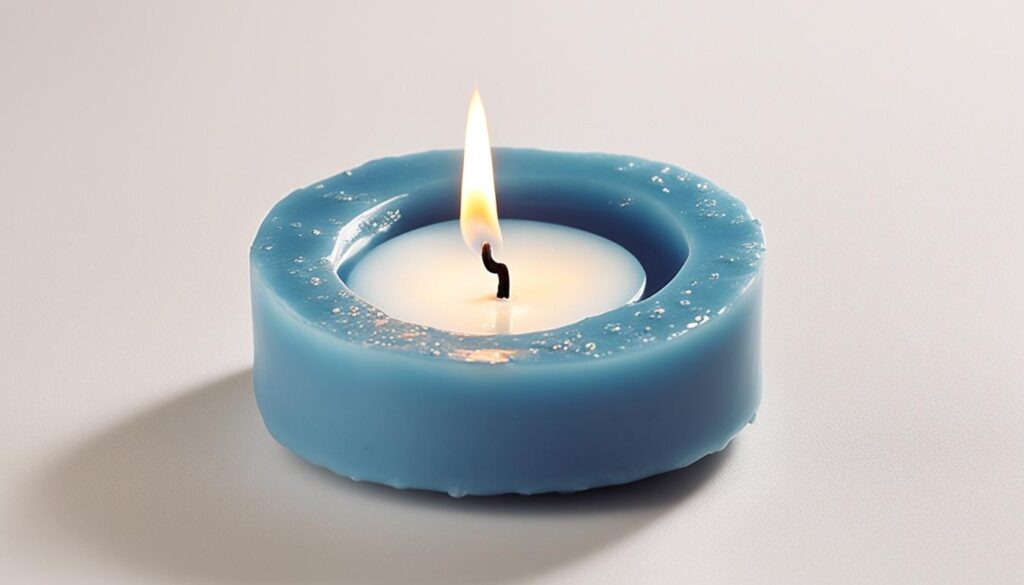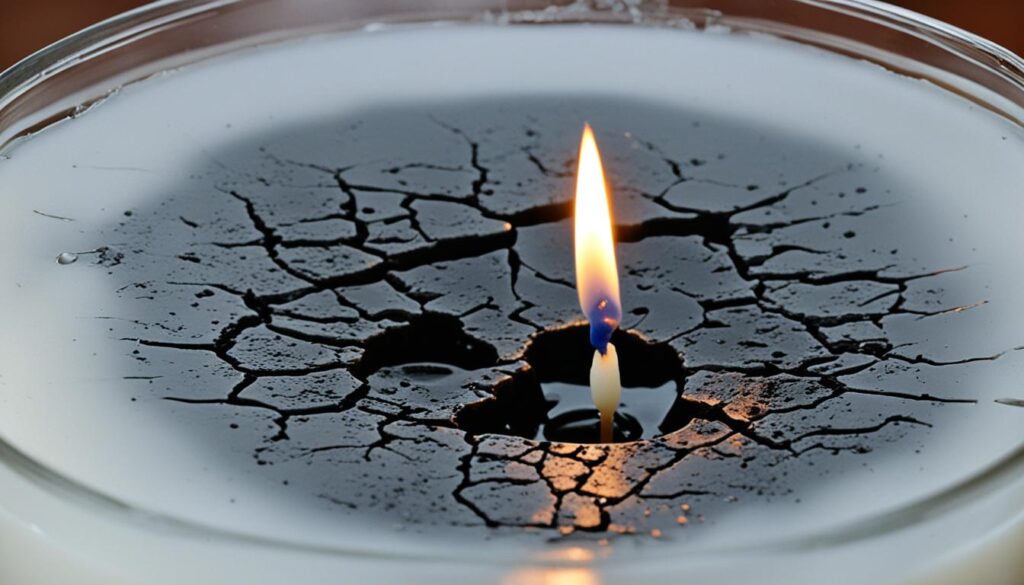Troubleshooting Common Candle Making Problems
Are your handcrafted candles not meeting your expectations? Facing issues like uneven wax or stubborn wicks? You’re not alone. Even experienced candle makers face challenges that can be frustrating. But don’t worry, this guide is here to help you fix common candle making problems. It will show you how to make perfect candles every time.
Key Takeaways
- Discover effective strategies to address a wide range of candle making issues, from wet spots and frosting to tunneling and air bubbles.
- Learn how to diagnose the root causes of your candle problems and implement targeted solutions for consistent, professional-quality results.
- Gain the confidence to experiment, troubleshoot, and fine-tune your candle making techniques, empowering you to become a true candle-crafting master.
- Unlock the secrets to creating candles that burn evenly, throw off robust scents, and maintain their visual appeal throughout their lifespan.
- Explore expert tips and industry insights that will revolutionize your approach to candle making and propel your creations to new heights of excellence.
Introduction to Candle Making Issues
Making candles might seem easy, but even experts face many challenges. Issues like common candle making problems such as wet spots and frosting can happen. These candle making troubleshooting issues make the learning curve steep. But, by tackling these problems, you can improve your skills and make perfect candles.
Common Pitfalls in Candle Crafting
Candle making is a mix of art and science. Even pros can run into common candle making problems, such as:
- Wet spots and poor wax adhesion
- Frosting and crystallization
- Bumpy “cauliflower” tops
- Tiny flames or self-extinguishing wicks
- Tunneling and uneven burning
- Air bubbles and foaming
Embracing the Learning Process
These candle making issues can be tough, but they’re part of the journey. By embracing the learning process, you can figure out why these problems happen. This way, you can overcome candle issues and make beautiful candles. This guide will help you solve candle making challenges and improve your skills.
Wet Spots and Poor Wax Adhesion
Candle makers often struggle with wet spots where the wax pulls away from the container. This problem can happen with different waxes like soy, paraffin, palm, and beeswax. It’s usually due to temperature changes during the candle’s life. Wet spots don’t affect how the candle works but can be fixed with some methods.
Causes and Prevention Techniques
The main reason for wet spots is the wax’s contraction and expansion when it cools and heats up. This can happen during making the candle or when it’s being used. To avoid wet spots, try these tips:
- Preheat the containers before adding wax. This helps the wax stick to the container sides.
- Pour the wax slowly and steadily, avoiding quick temperature changes.
- Tap the jars gently to remove air bubbles that can cause wax adhesion problems.
- Choose a softer wax blend, as harder waxes tend to pull away from the container walls.
Using these methods can greatly lower the chance of wet spots in candles. It also helps with candle wax adhesion, making your candles look better and last longer. Making sure to prevent wet spots in candles is key to creating top-quality candles.
“Maintaining proper wax adhesion is crucial for creating beautiful, long-lasting candles. With the right techniques, you can prevent those unsightly wet spots and enjoy a flawless candle-making experience.”
Frosting and Crystallization
Candle lovers often see a common issue called candle frosting. This is also known as candle wax crystallization. It mainly happens in soy wax candles. Crystals form because of temperature changes and time, a process called polymorphism. Candle frosting doesn’t harm the candle’s use but can look bad.
To lessen candle frosting and stop candle wax crystallization, try these methods:
- Slowly mix the wax and fragrance for a uniform blend.
- Heat the containers before pouring to keep temperatures steady.
- Let the wax cool before pouring to slow down crystals.
- Add a bit of paraffin or coconut wax to the mix to reduce candle frosting.
Right curing and storage are key to preventing candle frosting. Keep your candles in a cool, dry spot with little temperature change. This helps keep them looking good.
“Embracing the learning process and experimenting with different techniques is key to mastering the art of candle making and overcoming challenges like candle frosting.”
By knowing why candle frosting happens and using these tips, you can make candles that look great for a longer time. This way, you avoid the issue of candle wax crystallization.
Bumpy “Cauliflower” Tops
Candle makers often struggle with bumpy or “cauliflower” tops. This issue is like frosting and comes from wax’s uneven cooling. Soy wax is especially prone to this because temperature changes during cooling create wax crystals.
To avoid candle bumpy tops, follow these steps:
- Let the wax cool as much as possible in the pour pot before moving it.
- Preheat the candle containers to help the wax cool evenly.
- Keep the candles in a warm, steady place as they cool to avoid temperature changes.
If you get cauliflower tops in candles, don’t worry. Use a heat gun or hair dryer to melt the wax top. This makes it smooth again and removes the bumps.
By using these tips and fixing bumpy candle tops, your candles will look great. The main thing is to control the cooling and make sure the wax sets evenly. This works for any wax type.
Tiny Flame or Self-Extinguishing
If you love candles, you might have faced the issue of a small flame or one that goes out on its own. These problems often come from wick issues. But, there are ways to make your candles burn well again.
A common reason is a wick that’s too short. Fix this by removing wax to show at least 1/4 inch of the wick. This lets the flame grow. Sometimes, a wick isn’t primed right. Before lighting it, try rubbing wax on the wick to help it catch fire better.
Another issue is clogged wicks. If things like mica, glitter, or certain oils block the wick, it can’t draw wax up properly. In these cases, you might need a new candle, choosing ingredients carefully next time.
To prevent these candle wick problems later, test wicks before making candles. This helps pick the best wick for your wax and recipe. It ensures you won’t have tiny candle flame or candle self-extinguishing issues.
“The key to a successful candle-making experience is understanding the nuances of your wicks and wax blend.”
Tunneling and Uneven Burning
Candle lovers often face a common issue: “candle tunneling.” This happens when the wick burns a hole down the candle’s center, leaving the edges untouched. It’s usually due to a wick that’s too small or not enough burning time. But don’t worry, there are ways to fix this and stop it from happening again.
First, try burning the candle for a longer time. This lets the wax melt to the container’s edges, making the candle even. Or, you can remove the wax ledge by digging or cutting it off. This creates a flat surface before you light the candle again.
To avoid tunneling in the future, play with different wick sizes. Find the best one for your candle recipe and container. Also, make sure the first burn is long enough to let the wax reach the edges. This helps ensure your candles burn evenly.

The journey of candle making is about learning and finding what works for you. With some trial and error, you can prevent candle tunneling. This way, you’ll get perfect, evenly burning candles every time.
Air Bubbles and Foaming
Air bubbles are a common problem for candle makers. These bubbles can make the surface of your candles look uneven and foamy. But don’t worry, there are ways to get rid of them and make your candles look professional.
Eliminating Trapped Air
To stop air bubbles, focus on keeping the containers dry before adding wax. Also, pour the wax when it’s a bit warmer and do it slowly. This helps the wax flow better and reduces air pockets.
If you see bubbles on your candles, try tapping the pour pot gently. This can help push the air out and make the surface smoother. Even though bubbles don’t harm the candle, getting rid of them makes your candles look better.
“The key to preventing air bubbles in candles is to address the root cause – the introduction of air during the manufacturing process.”
troubleshooting candle making problems
Candle making is a fun craft, but it has its challenges. You might see wet spots, frosting, tunneling, or wicks that go out on their own. These common candle problems are normal and can help you grow as a maker.
Knowing how to fix these issues can make your candles better. With the right solving candle issues tips, you can make candles that look great and please everyone. Let’s look at some common troubleshooting candle making problems and how to fix them.
Addressing Wet Spots and Frosting
Wet spots and frosting can be annoying. They often come from cooling issues, temperature changes, or low-quality wax. Here’s how to avoid them:
- Keep your candle-making area at a steady temperature while cooling.
- Use a wax blend that doesn’t separate or frost easily.
- Try different cooling methods, like a dry place or a fan for even cooling.
Tackling Tunneling and Uneven Burning
Tunneling, where the wax burns down the middle, leaves a ring around the edges. This can happen for many reasons. Here’s how to fix it:
- Make sure the wick size matches your candle’s diameter.
- Try different wax types or additives for even burning.
- Trim the wick to the right length before each use to control the flame.
By paying attention and using these solving candle issues tips, you can beat many candle making challenges. Every problem is a chance to learn and get better at your craft.
“The true secret of happiness lies in taking a genuine interest in all the details of daily life.” – William Morris
Cracking and Sinkholes
Making candles can be fun, but sometimes they crack or have sinkholes. These issues can ruin the look and performance of your candles. But, you can easily avoid them with some simple tips.
Preventing Candle Cracking
Candle cracking happens when the wax cools too fast. This can be due to cold containers, low room temperature, or speeding up the cooling process. To stop cracking, let your candles cool slowly at room temperature, between 64-68°F (18-20°C).
Also, warming up the containers before adding wax helps with a steady cooling process.
Avoiding Candle Sinkholes
Sinkholes appear due to the wax expanding and contracting as it heats and cools. Pouring the wax when it’s cooler and warming the containers first can reduce sinkholes.
| Candle Issue | Cause | Prevention Techniques |
|---|---|---|
| Cracking | Rapid cooling of the wax |
|
| Sinkholes | Expansion and contraction of wax during heating and cooling |
|
By using these easy tips, you can prevent candle cracking and candle sinkholes. This way, your homemade candles will look great and work well.

Lack of Scent Throw
If your lit candle doesn’t smell as strong as you’d like, there could be a few reasons. Not giving the candle enough time to cure, adding fragrance oil at the wrong temperature, or using too little fragrance can cause a weak candle scent throw. Candles need 1-2 weeks to cure fully, letting the fragrance blend well with the wax and wick.
Adding fragrance at the right temperature is key for a good scent release. Also, start with a small amount of fragrance and adjust it as needed. This way, you can find the perfect balance for a strong, consistent candle scent throw.
Understanding why your candles don’t smell great and finding ways to improve candle fragrance can help you make better candles. Check out the Candle Making Troubleshooting Guide for tips on improving your candle-making skills.
“The key to a captivating candle lies in its ability to fill the room with a delightful, long-lasting fragrance.”
Smoke and Mushrooming Wicks
If your candle is making too much candle smoke or the wick looks like a mushroom, the wick size might be wrong. A wick that’s too big will burn the wax too fast, causing smoke and mushrooming candle wicks.
To fix this, try different wick sizes until you find the right one for your candle and container. Make sure to trim the wick to 1/4 inch before lighting it again to stop smoke and carbon buildup. If it still doesn’t work, think about using a different wick type that fits your wax and scent better.
Troubleshooting Smoky Flames
Here are some tips to fix smoky candle flames:
- Adjust the wick size – Use a smaller wick if the flame is too big and smoky.
- Trim the wick regularly – Keep the wick cut to 1/4 inch before lighting to stop mushrooming.
- Check the wax and fragrance blend – Make sure the wick works well with your wax and scent.
- Consider a different wick type – Switch to a wick that’s better for your candle mix if smoke keeps happening.
Fixing the smoky flames will give you a clean, even burn from your homemade candles.
“The key to a clean-burning candle is finding the perfect wick-wax match.”
Conclusion
Candle making is a rewarding craft that needs patience and a willingness to learn from mistakes. This guide helps you overcome common candle making challenges. It teaches you how to make high-quality, flawless candles.
Every problem you face is a chance to improve your skills. It brings you closer to candle making perfection. So, embrace the learning process and enjoy making candles that delight you and your customers.
With the right mindset and this guide’s knowledge, you’ll improve your candle making skills. You’ll get the results you want. Whether you’re experienced or new to candle making, these insights will help you. They’ll let you solve common problems and elevate your craft.
Keep exploring and experimenting. Let your passion for candle making lead you. Create exceptional, trouble-free candles that add joy and ambiance to your home and beyond.
FAQ
What are some common problems encountered in candle making?
How can I prevent wet spots in my candles?
What causes frosting in soy wax candles and how can I minimize it?
Why do some candles develop bumpy or “cauliflower” tops, and how can I prevent this?
What can I do if my candle wick is causing a tiny flame or the candle is self-extinguishing?
How can I prevent tunneling, where the wick burns a hole down the center of the candle?
What causes air bubbles or foaming in my candles, and how can I eliminate them?
Why are my candles cracking or developing sinkholes, and how can I avoid these issues?
Why can’t I detect the fragrance from my lit candle, and how can I improve the scent throw?
What should I do if my candle is producing excessive smoke or the wick is forming a mushroom-shaped carbon build-up?
Source Links
- https://villagecraftandcandle.com/blogs/news/top-10-candle-making-problems-and-how-to-solve-them – Top 10 Candle Making Problems and How to Solve Them – Village Craft & Candle
- https://www.candlescience.com/wax/soy-wax-trouble-shooting-guide/ – Soy Wax Troubleshooting Guide
- https://www.craftovator.co.uk/blogs/academy/candle-making-how-to-handle-the-most-common-issues – Common Candle Making Issues and how to handle them?
- Fragrance That Wows: A Beginner’s Guide to Adding Scents to Your Homemade Candles
- best essential oils for candles
- wood wick guide
- how to make candles smell stronger
- how to ship candles
- how to fix soy wax frosting
- wick Guide how to choose the right wick size with chart
- how to make candle molds
- how to clean candle wax
- how to reuse candle jars
- soy wax candle troubleshooting
- best wax melter for candle making
- how to conduct burn test
- why candle flickering crackling smoking
- how much wax per candle
- how to make candles smell stronger
- Easy Ways to Increase the Scent Throw of Your DIY Candles
- How to Make Candles for Meditation and Relaxation
- Using Upcycled Materials in Candle Making
- How to Make Hand-Poured Candles: Tips and Techniques

Leave a Reply